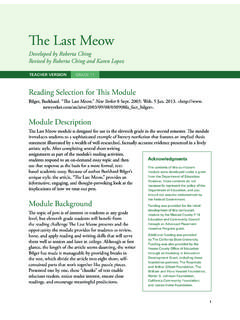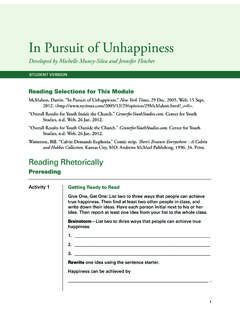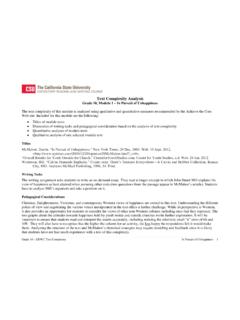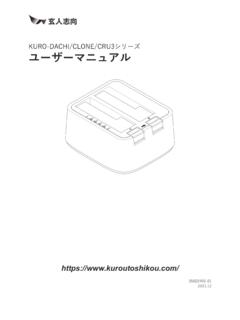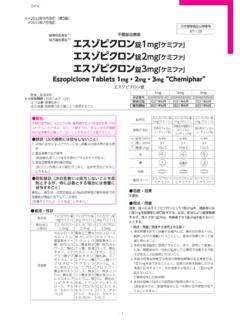Transcription of To Clone or Not to Clone - Bell English Department
1 To Clone or Not to Clone Developed by Marcy Merrill TEACHER VERSION GRADE 11. Reading Selections for This Module Said, Carolyn. Here, Kitty-Kitty-Kitty-Kitty. San Francisco Chronicle 15 Apr. 2004: A1. Print. Supplementary Readings Click and Clone . The Genetic Science Learning Center, University of Utah, 2013. Web. 24 Apr. 2007. < clickandclone/>. Is It Cloning? Or Not? The Genetic Science Learning Center, University of Utah, 2013. Web. 24 Apr. 2007. < cloningornot/>. Acknowledgments Module Description The contents of this curriculum This unit could occur at the end of a larger unit on module were developed under a grant genetics in a biology course or as a unit in an English from the Department of Education.
2 Or journalism course. Although it is designed for the However, those contents do not necessarily represent the policy of the beginning of eleventh grade, it could be used for science Department of Education, and you as early as ninth grade with proper scaffolding and ample should not assume endorsement by background information. The extra readings are included the Federal Government. to provide background information for students. The Funding was provided for the initial module, which will take approximately two weeks to development of this curriculum module by the Merced County P-16.
3 Complete without the supplementary readings, focuses on Education and Community Council types of genetic technologies with an emphasis on cloning through an Advanced Placement and stem cells, both their uses and the controversy Incentive Program grant. associated with them. Additional funding was provided by The California State University. Funding was also provided by the Module Background Fresno County Office of Education through an Investing in Innovation The Said article reports on a company in Sausalito, Development Grant, including these foundation partners: The Rosalinde California Genetics Savings & Clone that preserves and Arthur Gilbert Foundation, The and banks the genetic material of their clients' pets William and Flora Hewlett Foundation, in order to Clone them in the near future.
4 The article Walter S. Johnson Foundation, includes quotes from ethicists, animal rights groups, California Community Foundation, and James Irvine Foundation. the president of Genetics Savings & Clone , and 1. GRADE 11 TEACHER VERSION. their prospective clients. At the end of the article is a step-by-step summary of how cloning is accomplished by somatic cell nuclear transfer. The key question Should cloning be allowed or approved? has multiple political, ethical, and personal implications that will be addressed throughout the module. About the Author Carolyn Said is a staff writer at the San Francisco Chronicle.
5 As a business reporter, she seeks to weave people's personal stories with statistical analyses to illuminate sweeping economic trends, such as the current subprime mortgage meltdown. During 11 years at the Chronicle, she has covered the dot-com rise and fall, the California energy crisis, the corporate malfeasance scandals, and the human fallout from the economic downturn. Her work has received awards from the California Newspapers Publishers Association, the Northern California Society of Professional Journalists, and the Peninsula Press Club. Module Objectives In addition to the focus on Common Core State Standards, the module targets the skill areas listed below.
6 Students will be able to Evaluate current issues in science and other content areas through careful consideration of all sides to the issue Demonstrate an active interest in cutting edge scientific technology and the ways it may impact their lives in the future Advocate by writing and providing verbal support for a cause or position Summarize the steps used to Clone organisms Explain the differences between reproductive and therapeutic cloning Evaluate arguments for and against cloning to develop their own opinions Along with the Common Core State Standards for English Language Arts and Literacy, disciplinary content in a biology course will focus on related standards in a genetics unit: Concept 5.
7 The genetic composition of cells can be altered by incorporation of exogenous DNA. into the cells. Standard 5c. Students know how genetic engineering (biotechnology) is used to produce novel biomedical and agricultural products. Note: The activities for students provided in the Student Version for this module are copied here in the Teacher Version for your convenience. The shaded areas include the actual activities the students will see. The use of italics in the shaded areas generally indicates possible student responses and may be interspersed with notes to the teacher that are not shaded.
8 If there are notes to the teacher within the shaded areas, they are indicated by italics and parentheses. 2 | TO Clone OR NOT TO Clone CSU EXPOSITORY READING AND WRITING MODULES. TEACHER VERSION GRADE 11. Common Core State Standards for English Language Arts and Reading Rhetorically Literacy Unless otherwise specified, all standards Prereading are for grades 11-12. The strategies in this section of the Getting Ready to Read ERWC are designed to prepare students For use prior to or during the module, here are several opportunities for in advance of reading disciplinary knowledge extensions, assessment of the materials, and sites for increasingly complex and sophisticated further exploration or teaching: texts.
9 These brief, introductory activities 1. Show students the Click and Clone , The Genetic Science Learning will prepare students Center, University of Utah Web site: to learn the content of California's Common content/tech/cloning/clickandclone/. Click and Clone animation. (2007). Core State Standards (CCSS) for English Retrieved April 24, 2007, from Genetic Science Learning Center, Language Arts (ELA) University of Utah Web site. and Literacy in the sections of the module 2. Introduce the difference between Reproductive and Therapeutic Cloning that follow. by providing a definition of each.
10 3. Check for understanding with a brief interactive quiz: Is it cloning? Or Not? The Genetic Science Learning Center, University of Utah Web site: 4. Show students a timeline of cloning to reinforce that people have been experimenting with this technology since the late 1800s. Tell them about the vote in April 2012 in the Senate to ease the restrictions that had been placed on stem cell research. Remind them that cloning is a very timely issue that we, as a society, will need to make careful decisions about in the near future. The strategies in this section of the Exploring Key Concepts ERWC are designed to prepare students The two student activities described here assess what students already know in advance of reading about cloning and provide some background information for students so they increasingly complex and sophisticated can comprehend the text when they begin to read.
